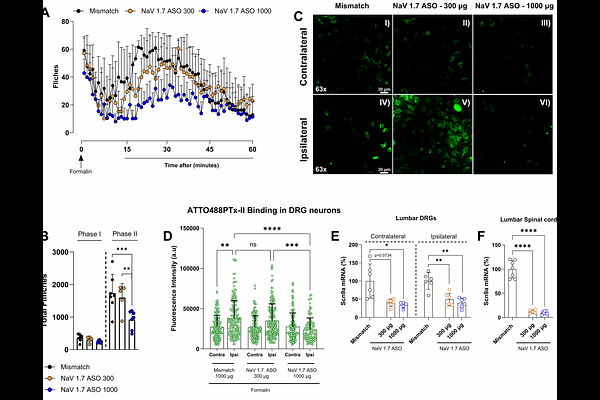Analgesic actions of Intrathecal NaV 1.7 antisense in rats: loss of antagonist channel binding, message depletion, and neuraxial distribution of oligonucleotide

Analgesic actions of Intrathecal NaV 1.7 antisense in rats: loss of antagonist channel binding, message depletion, and neuraxial distribution of oligonucleotide
Malange, K.; Lemes, J. B. P.; Noble, B.; Anchondo, Y.; Urbina, C. M.; Jadhav, S.; Dochnal, S. A.; Kambalimath, C.; Alvarez, P.; Fitzsimmons, B.; Mazur, C.; Kordasiewicz, H.; Dore, K.; Zhao, H.; Yaksh, T. L.
AbstractBackground: Genome targeting strategies to address NaV 1.7 mediated signaling in nociceptive afferents produce highly selective and persistent analgesic outcomes. Here, we analyze the concentration-dependent effects of the reduction of primary afferent NaV 1.7 channel expression by intrathecal delivery of an antisense oligonucleotide on pain behaviors and the covariance of Scn9a knock-down on NaV 1.7 message expression and channel binding. Methods: Male Sprague-Dawley rats were implanted with lumbar intrathecal catheters and dosed with different NaV 1.7 ASO concentrations (100 to 3000 & [micro]g;10 {micro}L). Pain behavior assays were conducted 0-28 days after ASO injections. Brain, spinal cords (SC) and dorsal root ganglia (DRGs) were collected. Quantification of ASO knock-down was assessed through RT-qPCR. NaV 1.7 expression was assessed by binding of NaV 1.7 fluorescent labeled antagonist (ATTO488PTx-II). Distribution studies were performed using anti-ASO antibody staining in brain, SCs and DRGs. Results: NaV 1.7 message was detected in nerve, DRG and SC. Intrathecal ASO induced a concentration dependent gradient of knock down in DRGs (lumbar to cervical) of Scn9a mRNA and ATTO488PTx-II binding in small DRG neurons, and in spinal parenchyma, and a suppression of pain behaviors initiated by mechanical compression, inflammation and following intraplantar NaV1.7 agonist (OD1) or formalin. At 1000 {micro}g, there was a 47% reduction in phase 2 flinching, a 60% reduction in DRG mRNA and a 36% reduction in ATTO488PTx-II DRG binding in comparison with mismatch controls. Although marked changes were seen at the sensory ganglia level and spinal dorsal horn, no changes in NaV 1.7 binding or mRNA were detected in sciatic nerves. Reduction in DRG message displayed a rostro-caudal gradient that corresponded with ASO distribution. Conclusions: The study presents how NaV 1.7 ASOs reduce primary afferent channel binding through an effective knock-down on Scn9a mRNA, and channel binding leading to a covariate reduction in pain behavior.